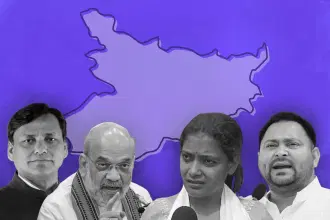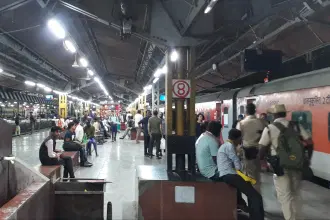States
Madhya Pradesh: The Sanatani Heart Of Incredible India
Aashish Chandorkar
Nov 01, 2025, 10:24 AM | Updated 10:25 AM IST
Save & read from anywhere!
Bookmark stories for easy access on any device or the Swarajya app.


In the winter months that lie ahead, Indore – by the virtue of its tag as the cleanest city of the country – will get hoards of visitors from around India, most of whom will add Ujjain and Omkareshwar to their travel itineraries. The two jyotirlingas of Madhya Pradesh are amongst the holiest and the most popular religious travel destinations for the followers of Sanatan Dharma, and specifically the devotees of Lord Shiv.
Likewise, the temples of Khajuraho, built in the tenth century by the Chandela dynasty and recognized as UNESCO World Heritage Site, have also been long recognized as a popular travel destination.
But other than Khajuraho and the Ujjain and Omkareshwar jyotirlingas, Madhya Pradesh has many other iconic temples not as well known or appreciated. In fact, the state is home to some of the most unique and historic temple sites, still not as patronized by the visitors relative to their religious significance.
Bhojeshwar Mahadev Temple (Bhojpur)
Raja Bhoj, one of the greatest rulers of the Parmar dynasty, who ruled the Malwa region for more than four decades in the eleventh century, was also one of the most accomplished engineers India has produced. The Bhojeshwar temple in Bhojpur village in the Raisen district, which overlooks the Betwa river, is however one of Raja Bhoj’s incomplete masterpiece. Currently on the Tentative List of the UNESCO’s World Heritage Sites, the temple complex adorns a 7.5-feet tall Shivaling.
The Archaeological Survey of India has done critical work in the preservation of this temple, including the involvement of the legendary conservator Shri KK Muhammed in 2006. There aren’t any markings on inscriptions of the wall either and no inscription has been found outside the temple too. It would have been one of the largest temple complexes in the country today, had it been completed.
Bhojpur lies just 30 kms from Bhopal, which is well connected by all modes of transport.
Ram Raja Temple (Orchha)
Orchha is the best-known Ramayana site in Madhya Pradesh. Lord Ram is still worshipped as the reining ruler of Orchha. In this temple, Shri Ram sits in a Padmansana pose, crossing his left leg over his right thigh. The Ram Raja mandir was constructed by Ganesh Kunwari, the queen of the Bundel king Madhukar Shah Judev almost 450 years ago.
Legend has it that the queen was an ardent Lord Ram devotee. She wanted to bring Lord Ram in his baal avtar to Orchha. While she was meditating in Ayodhya on the banks of Saryu river, Lord Ram appeared in her dreams and agreed to come to Orchha on the condition that he will be the king of the land.
Since then, the Orchha Bundel kings have since accept Lord Ram as the real ruler of their kingdom, administering their territory in His name.
Orchha is 120 kms from Gwalior and just 20 kms from Jhansi, both well connected by rail with the rest of the country. Gwalior is increasingly seeing better air connectivity too.
Chaturbhuj Temple (Gwalior)
The Chaturbhuj Temple is a small temple in the iconic Gwalior Fort complex, said to have been built in the year 875 AD. The temple, carved in a monolithic rock, is devoted to many deities. But the most prominent ones are four-armed Lord Vishnu and four-armed Goddess Lakshmi. This explains the name “Chaturbhuj”, which literally translates to four arms.
However, apart from the religious and archaeological significance, the temple has to its credit a hugely important historical fact. One of the inscriptions in the temple contains the oldest known stone-inscribed epigraphical evidence of the number 0 (zero). This inscription is found in the mention of a garden plot which produced 50 garlands of flowers every day for the temple.
Unfortunately, as is the case with most old North Indian temples, the interior of the temple, including the faces on various carvings are damaged.
Chausath Yogini Temple (Morena)
While temples dedicated to the collection of sixty-four (chausath) yoginis – female masters of yoga – are found in many parts of India, the one in Mitaoli near Morena is perhaps the best known of these temples.
The Mitaoli temple, like all other yogini temples, is circular in shape with the central court devoted to Lord Shiva. The sixty-four niches in the circular complex each housed statue of one yogini each. The temple complex has no roof and is open to the skies.
This temple is said to have inspired the architecture of the old Indian Parliament, which had a similar-looking pillar structure organized in a circular shape.
In fact, there are other yogini temples in Madhya Pradesh too, for example those in Khajuraho and in Jabalpur. The latter one at Bhedaghat, named Golaki Math, has eighty-one instead of the usual sixty-four yogini statues.
Morena is just about an hour away from Gwalior.
Pashupatinath Temple (Mandsaur)
The Pashupatinath Temple in Mandsaur is dedicated Lord Shiva with an eight-faced Shivling. The temple site has been referred to as Dashapura, which has been mentioned in various antient texts, including those by Kalidas.
The temple which overlooks the Shivna river, is said to have been built in the Gupta empire era in the fifth century. The Shivling, about 7.5 feet tall, is a rare “astamukhi” form of Lord Shiva.
Mandsaur lies 220 kms north of Indore about 185 kms east of Udaipur, both cities well connected by air.
As Madhya Pradesh celebrates its Foundation Day on 1 November and completes 69 years of existence in the current shape, one hopes that these unique religious sites attract greater attention. As the state chases its $2-trillion economy dream, to be achieved by 2047, up from $180-billion odd today, tourism economy has to become one of the pillars of this growth strategy.
This is a source Madhya Pradesh is well-placed to tap, as its temple sites, though not fully intact, remain some of the most prominent witnesses of the force and the grandeur Sanatan Dharma was in north India.
Aashish Chandorkar is Counsellor at the Permanent Mission of India to the World Trade Organization in Geneva. He took up this role in September 2021. He writes on public policy in his personal capacity.





